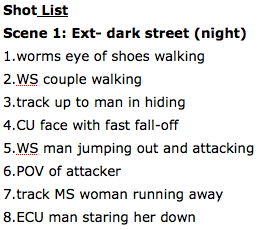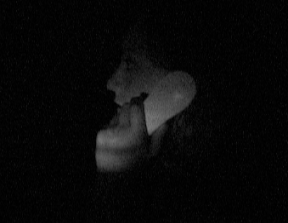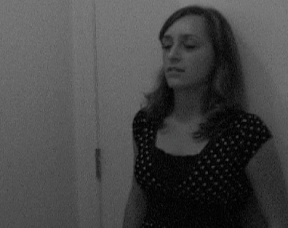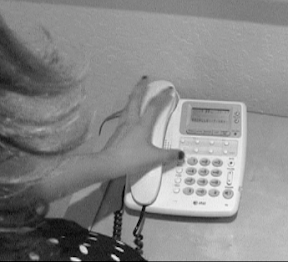Fontaine, Jenna 3˚ 12/8/09 Short Film Commentary “The Witness”
First we did some brainstorming on the plot and how we could relate it to Film Noir. Next we created a treatment including a tentative title, actors, and the story line.

From FilmNoirProject
Mitchell and I worked most on the treatment. We had some trouble agreeing, but we tried to incorporate each of our ideas. We had to tweak some things in order to get it approved. After that I came up with a script of all of the dialogue and actions.

From FilmNoirProject

From FilmNoirProject
Then I made a two-column script of our shots for all six scenes while Miles did the audio.

From FilmNoirProject

From FilmNoirProject
Lastly, we created blocking diagrams- we each did a scene. On our first day of shooting, we had a defective camera, so we couldn’t shoot for the entire weekend. Also, the actress couldn’t make the other days we needed to shoot, so we got another one, Jessica. After that we shot maybe four times with either all or most of the crew, each either a scene or a couple depending on the length.

From FilmNoirProject
Whenever we got new footage we would edit it on our own and then at the end I connected the segments.
The actress Jessica was an appropriate selection for the main character because she is a young woman who can pull off some serious scenes. I think it looked mostly believable for a first time actress. Sometimes it seemed like she was exaggerating emotions too much, but it didn’t sound like a joke. I don’t think she has a distinct personality for this specific character, but she has enough to show the character’s emotions. There is only one girl wearing a polka-dot blouse, so there isn’t any confusion of characters. Miles is good for his role because he is a young guy with legitimate acting experience, so he can slip into character easily so that he looks believable. I don’t think he relates too much to his character, but I don’t think it can be seen in the film that he can’t play the part. Miles and Mitchell both have blond hair, but they are wearing distinctly different clothes, such as how Mitchell has a ski mask on the whole time. Mitchell really wanted to be the bad guy, so I knew he would take the part seriously. He also has the bangs, which give a Cyclops look with the ski mask, which looks cool with the right lighting. I think when he has a serious face on, the character works really well.
 |
| From FilmNoirProject |
I think Jessica captures the audience when the killer comes for her because of the fear shown through close-ups, especially of her eyes. Mitchell is really a suspicious character because of the ski mask, so I think that instills fear in the audience. The shot of dead Miles along with the sad music makes the audience feel sorrow. I think Jessica is only acting her role because it seems like she doesn't know what it's like to be in that situation, so it's hard to be the character. Mitchell was able to "be" the character because he had the attitude a stalker would have (no offense =P) Miles didn't have much of a part, but he did a good job at hitting Mitchell with passion. The slow knocking and Jessica's gasp are meaningful because its the climax of the film, the gasp is motivated because this creeper is knocking on her door, and its appropriate for the TV because the closeup of Jessica grabs the audience.

From FilmNoirProject
When there's dialogue, which isn't often, it uncovers the entire meaning of the killing and is said with feeling, so there's only meaningful dialogue. Jessica seems to stay in a panicked and wary character throughout the film. Mitchell definitely stays in a creeper state throughout as well. No because if it's non-dramatic it'll sound monotone, but if it's dramatic it'll be passionate. Jessica can sound lifeless at times, but Mitchell stays in character the whole time.
There is only dialogue when necessary, so it's always in character because it helps solve the mystery behind the murder. It definitely works for the setting and helps the plot as well as shows the killer's creepy personality. The two main characters are so distinct, so their dialogue is as well because the girl shows confusion while the killer gives an explanation of the situation. The dialogue is cut down so much that there's only a few lines of dialogue at the end because otherwise the audience wouldn't know the motive of the killer. I think the plot is fairly easy to follow, save some continuity issues such as how the lights are on when the girl returns from outside after the power went out.

From FilmNoirProject
There is development because the girl finds out why the killer did what he did, and she is no longer safe from the killer. I think it meets the genre's expectations because of scary aspect of thrillers and the discovery of motive found in murder mysteries. A thriller should get the audience on the edge of their seats with fright and anticipation. A murder mystery should get people to think about why the murderer did what he did.
The ski mask tells us that the killer is up to no good and he doesn't want anyone to identify him.

From FilmNoirProject
The polka-dot shirt Jessica is wearing shows us that this is Jessica we're looking at so that she is easily distinguished. The clothes also fit the present time the story takes place.

From FilmNoirProject
The dark clothes Mitchell is wearing represent his dark personality. The make-up on Jessica isn't a lot, but it's enough. When Jessica is wearing the jacket, it's the murder scene. All of the other times she just has the shirt. Mitchell stays dark the whole time, and Jessica isn't too bright. The make-up matches and isn't too much to be distracting for close-ups and long shots.
The only sound effect that I can think of, which is actually a VO, is when Miles hits Mitchell with a frying pan, and I think the distance is fine for the loudness. I think all of the background music reflects either what's going on or the emotions of the character. All of the music has an eerie, sad, or strange tone, which fits the aspects of the film. Sometimes there is a fast pace to represent action, and its slower when there isn't much action. The music isn't too loud, and it's easier to avoid music too loud for the dialogue because there's little dialogue.
A modern character and setting can be determined by the modern living room.

From FilmNoirProject
The dark garage is perfect for the last creepy scene, and the dark, lonely murder location is good for the first scene.

From FilmNoirProject
The sets offered space for characters to move and the first set gives Mitchell a good hiding spot to jump out from. The living room made lights that weren't supposed to be on difficult to avoid. The only part with low audio was Jessica for the first line in the last scene, but the rest seemed fine. The garage supports Mitchell's attitude, and the black and white set vs. Jessica's shirt keep the attention on her. The props are all things used in this time period.
The lighting seems to stay the same except for when the power goes, during which it is darker (but still visible), except for those couple shots with the lights visibly on. There is good key on Jessica or Mitchell to show the emotion of them and focus on the character. The fill and back illumination don't seem to apply much in the film. There are no unnecessary shadows present. The low intensity of light clearly implies that its nighttime throughout the film. The black and white effect represents the darkness of the film. The spotlight on Jessica when the power goes out implies a streetlight shining inside on Jessica. It also emphasizes Jessica’s mood.
 |
| From FilmNoirProject |
I think the opening titles go great with the music and style of the film. The scrolling text at the end is white text on black, which matches the black and white style of the film. The credits can be read clearly and are inside the margins. The titles are strictly before and after the film, so they don’t interfere with any shots. The main title, which short, is on long enough to be read. The scrolling text can be read as well.
There are some shots involving the rule of thirds and a variety of shots with close-ups, extreme close-ups, medium shots, wide shots, and long shots.

From FilmNoirProject

From FilmNoirProject

From FilmNoirProject

From FilmNoirProject
The tilting during the dream sequence is appropriate, smooth, and motivated because Jessica’s head is to the side and she is “out of it.” Trucking with Jessica down the hallway represents the fast pace of the film at that point.

From FilmNoirProject
No movements draw attention to themselves, but the extreme close-ups of Jessica’s eye draw a lot of attention. The director seemed to have planned out the setups because of the smoothness of each shot. No zooms are seen in action, but some shots start far and then switch to a close-up. The only problem with focus was outside because the darkness made it hard to distinguish what it was supposed to focus on.
 |
| From FilmNoirProject |
The sound remains consistent except for one part of dialogue where it seems the volume had to be raised a lot to understand what she was saying. In this shot and the next there are noticeable differences in background noise. If the audio is meant to be heard, such as the footsteps down the hallway or the Mitchell’s dialogue, then it is heard clearly over the background music. Of course equipment, props, and scenery movements are controlled because with more than one camera in different places, there may be noises from it that get in the way of the intended audio. I didn’t notice any looped segments. The only sound effects are the little orchestra noises, such as when the power goes out. This affects the shot because it shows Jessica’s shock.
The cuts are all motivated to show the new focuses the camera is trying to show, such as when Jessica goes to the phone and it cuts to an over-the-shoulder shot with a closer look at the phone.

From FilmNoirProject
It works with the pace because the film, especially with its thriller genre, is relatively fast-paced. There is usually a medium or close-up on Jessica and the only point-of-view shots are hers, so the audience shouldn’t be confused. Each scene flows into the next smoothly without confusing the audience about the plot. If something important happens, there’s a close-up of Jessica’s reaction so I see what she’s seeing with her emotions as well, which is what I expect to see. The shots give coverage of the set while showing important moves the character makes and match-action cuts to show variety. The decision to cut out the first time she looked out the window and the dream sequence relieve move the story along at a faster pace and relieve confusion. The pacing seems to be fast throughout, but it slows down a bit when she gets home until she looks outside. I didn’t notice any technical and general continuity jump cuts. Each shot flows smoothly to follow the actions of the character, and the scenes begin with the information the audience was left with in the previous scene. Scenes or snippets that aren’t essential for showing the story have been removed so the film doesn’t seem to drag on. Each scene is movement and the characters actions show everything that’s happening, so the scene is cut down as much as possible so that the audience gets what it needs to understand.
The story tells itself through the actions of characters. The implied narrator of this kind of story is the character’s (victim’s) actions. The spectators bring their understanding of Jessica’s emotions. We provide the implication that Miles is killed when we see a point-of-view shot of Mitchell walking to him with the knife (fade-out) and then the next shot shows him dead on the ground. Everything is seen chronologically, except for the little flashback of the shot of Miles dead.

From FilmNoirProject
It is realistic because the whole thing occurs at night in a typical house and street. The genres are thriller, murder mystery and Film Noir. It’s in a modern phase because of the effects we can add to it, but the black and white implies the darkness of a classic murder mystery. The movie says that if one doesn’t watch out, anything can happen no matter how unrealistic it seems. This film embodies the universal human traits of what jealousy can lead a person to do as well as the fear of being hunted down. Mitchell’s dialogue is stylized so that we figure out his motivation to kill, but he doesn’t state it directly. Jessica’s dialogue is straightforward because it’s the killer’s answer we care about. We use Mitchell’s tone when he says his lines to find out “what’s bothering him.” We look at Jessica’s expression to decode her thoughts. The only motif is the idea of the power jealousy has over people. This enriches the story because it gives a juicy motive for Mitchell’s murder. This is told from Jessica’s point of view because she is the one we want the audience to feel for. The rapport we establish with the narrator (Jessica’s actions) is that we now understand what she’s going to do next without having to see the next shot.
The bad guys have a tone in their voice and wear clothes that hide their identity. The good guys may show fear or bravery in the face of the bad. Jessica was picked because she didn’t have any strong opinions for any of the characters, so we could make her be what we wanted. Mitchell had time to think about what his character would do, so he had the ideological values of a stalker/murderer at hand. The cinematic techniques, such as the focus on Jessica’s view, are meant to create the character Jessica is trying to be by showing facial expressions. The protagonist (Jessica) is a spokesperson for the filmmaker because what we see her do is what the filmmaker was trying to get across. The cultural values of creepers today are seen in the film. Women are portrayed as the weak victims of men’s battles over them. The film shows the creepy, fast-paced aspects of a thriller and the suspense behind a murder mystery. The film has a fearful tone because it’s seen from Jessica’s perspective. It reinforces how the character is supposed to feel and act like.
This film connects to Film Noir because of the entrapment Jessica feels when she is all alone after Miles is gone with no one to save her from the killer. Spotlights on Jessica show that with Miles gone, she is alone. The eagle-eye view of Jessica tied to the chair shows entrapment because it shows the low, helpless state she is in.

From FilmNoirProject
Fragility is also seen when we get close-ups of the fear in Jessica’s eyes after the power goes out.

From FilmNoirProject
Also, the gasps after Mitchell knocks on the door and after the power goes out show how weak she is. Because of ideologies, women are seen as weaker, so Jessica, being so typical in this film, represents this ideology. Also, there isn’t much lighting involved, and when there is, it’s extreme on what we want to focus on. There are also expressionistic sets because the picture of Miles keeps the memory with us as Jessica is going through all of this fear and vulnerability.

From FilmNoirProject